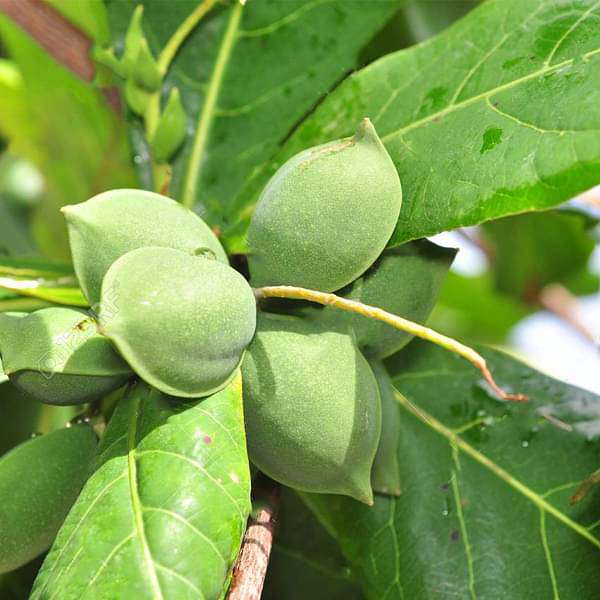Description
Terminalia catappa also known as Sea almond or Indian almond which is perennial evergreen or dry deciduous, edible fruit and nut.
The Indian Almond Tree (Terminalia catappa) also called Sea Almond or Tropical Almond belongs to the untrue mangroves and is very well known because of its leaves for the use in aquariums. It grows upright and forms a symmetrical crown with horizontal branches distinctively arranged in tiers. As the tree ages, the crown will become increasingly flattened and eventually take on a vase shape.Plant Specifications
Plant Height
19 inch (48 cm)
Plant Spread
5 inch (13 cm)
*above specification are indicative only. actual dimensions may vary by +-10%
Common Name
Badam, Indian Almond
Maximum Reachable Height
30-40 ft
Flower Colour
White to pale green
Bloom Time
February to may
Difficulty Level
Moderately
Planting and careDig out an area for the tree that is about 3 or 4 times the diameter of the container or rootball and the same depth as the container or rootball. Use a pitchfork or shovel to scarify the sides of the hole.If container-grown, lay the tree on its side and remove the container. Loosen the roots around the edges without breaking up the root ball too much.
Position tree in center of hole so that the best side faces forward. You are ready to begin filling in with soil.
If planting a balled and burlaped tree, position it in hole so that the best side faces forward.
Untie or remove nails from burlap at top of ball and pull burlap back, so it does not stick out of hole when soil is replaced.
Create a water ring around the outer edge of the hole.
Not only will this conseve water, but will direct moisture to perimeter roots, encouraging outer growth.
Once tree is established, water ring may be leveled.
Studies show that mulched trees grow faster than those unmulched, so add a 3 inch layer of pinestraw, compost, or pulverized bark over backfilled area.
Remove any damaged limbs.
Badam Tree care
Plants are almost completely made up of water so it is important to supply them with adequate water to maintain good plant health. Too much water frequently deprives oxygen leading to plant diseases such as root and stem rots.
Sunlight
Full Sun
Watering
Water regularly; do not overwater
Soil
Sandy, well-drained soil
Temperature
Hardy up to 4 degree C
Fertilizer
Young plants need extra phosphorus to encourage good root development. Look for a fertilizer that has phosphorus.Trees need to be fertilized every few years.
Badam Tree uses
Ornamental Use:
The Almond tree provides deep shade and has become a beloved ornamental tree in tropical gardens, parks and along streets
Medicinal Use:
Leaf extract exhibited potent anti-diabetic effects and suppress bone weight loss in ovariectomized mice
Ethanol leaf extracts displayed analgesic and anti-inflammatory activities
Culinary Use:
The fruit and seed are edible
Oil extracted from the dried nuts is edible and used in cooking in parts of South America
Indian almond leaves contain several different flavonoids, including kaempferol and quercetin
It is also rich in various tannins
It is astringent and bitter






Reviews
There are no reviews yet.